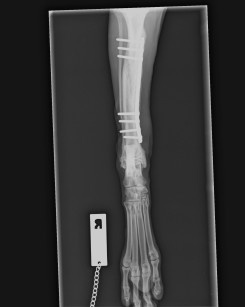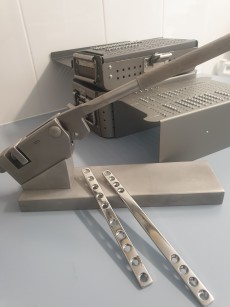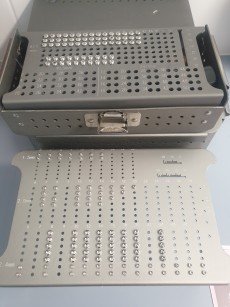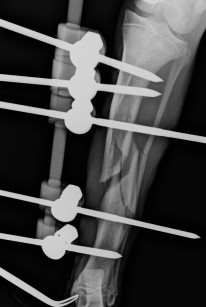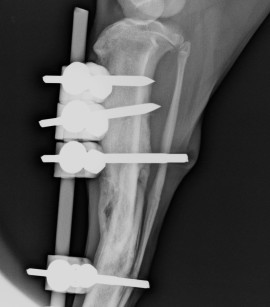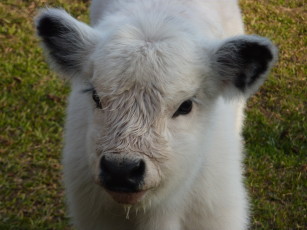It's not just what we know... it's how much we care!
Orthopaedic Surgery
Orthopaedic surgery involves repairing the bones and joints of dogs and cats so they can regain pain-free, normal function. At Wingham & Valley Vets we perform many different orthopaedic surgeries, ranging from simple to very complex. Some of the most common orthopaedic conditions that we are able to treat are fractures, luxating patellas and cranial cruciate ligament ruptures with TPLO surgery.
When is orthopaedic surgery necessary?
- Bone fractures
- Joint dislocations
- Cartilage defects
- Patellar luxation
- Ligament ruptures and injuries (including cruciate ligament rupture)
what can i expect when my pet has their surgery?
Generally, your pet will be admitted to hospital on the morning of their procedure after a period of fasting the night before. Your veterinarian will perform a thorough physical exam and pre-anaesthetic check, which may involve blood testing to rule out any liver or kidney problems prior to general anaesthesia. This is especially important in older pets that are more likely to have pre-existing disease.
After their pre-anaesthetic check we will administer a premedication which has several benefits. Your pet will be more relaxed and much less anxious, their general anaesthetic will be safer as we have to use less drugs to keep them asleep and their pain will be much better controlled once they wake up from anaesthesia. As soon as your pet has had their premed, we place blankets or coats on them to ensure their are kept warm, since hypothermia can be dangerous for animals who are anaesthetised. We continue ‘actively warming’ them throughout the surgery using a warm air devic called a ‘Bair Hugger’ to ensure their temperature is maintained.

High quality xray images are essential for a good surgical outcome. We have a state of the art Digital Radiography Suite.
All pets undergoing anaesthesia in our hospital are constantly monitored by a highly experienced Veterinary Nurse. Your pet will also receive intravenous fluids throughout their procedure to ensure their blood pressure is maintained and to help them process the anaesthesia drugs. We use advanced monitoring equipment that will continuously give us information about your pet’s body temperature, heart rate, breathing rate, oxygen saturation and blood pressure – every precaution is taken to ensure your pet’s comfort and safety.
All our equipment has been sterilised and our surgeons wear a full gown, masks, gloves and hair covering, and many patients will also receive peri-operative intravenous antibiotics to minimise the risk of surgical infection.
How are bone fractures repaired?
This depends greatly on the bone that is fractured, the age of the patient, whether the fracture is open or closed and how much damage has been sustained by the surrounding soft tissue structures. The first step of fracture repair is to get good quality diagnostic xrays so we can plan the surgery. We assess each fracture on a case by case basis and decide how much stability is required for the bone to heal effectively as well as the individual requirements of the patient. Older, large breed animals tend to require very rigid internal fixation (such as bone plate) whereas young animals that are not as heavy can go very well with an external fixateur.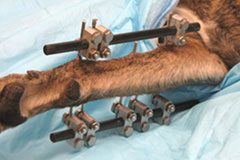
We are experienced with all different methods of fracture repair including:
- Bone plate and screws
- Intramedullary pin and cerclage wire
- External fixateur
- Lag screws or crossed pins
For extremely complex fractures or joint reconstructions, we enlist the expertise of a specialised surgeon who attends the practice and performs the procedure on your pet. This may be recommended to you if your pet has a very complicated fracture (such as a joint fracture or a fracture with many fragments) or if your pet has cranial crucial ligament rupture and you would like a repair known as a TPLO performed. Our recommendations are always guided by what we feel is in the best interests of your beloved pet.
post-operative care
After the surgery we will take post-op radiographs to assess the repair. Most pets will stay overnight on a pain relief (opioid) infusion to ensure they are comfortable before going home. Adequate pain relief is our priority and we want your pet to be as pain free as possible. When your pet is ready to go home, we will have a discharge appointment with you and your vet will explain our post-op care recommendations and the dosage of any take-home medications to ensure your pet has a speedy recovery without complications. This discharge appointment also allows you to ask any questions you may have. There will be several rechecks (and possibly some bandage changes) after most orthopaedic surgeries to ensure your pet is recovering well.
